PANIC DURING THE SWIM
Ron Saetermoe
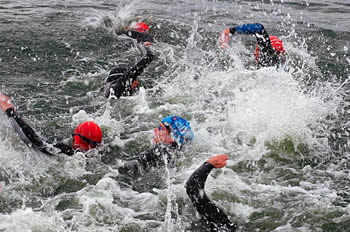
The bane of many a triathlete is the swim. They seem to enjoy the cycling and running training but pretty much hate everything about the swim.
With that hate comes fear. Fear of everything: getting kicked, losing goggles, drowning, sharks, etc. Coming from a swimming background I personally don’t get it but let me tell you a story, because I can relate.
The Ironman start is a mass-start, which means that you, along with 2000+ of your closest friends, all start at the same time. Stuff is just going to happen when you jamb that many people together – you just have to accept it.
Last year at Ironman Arizona I got into the freezing cold water (about 53 degrees) 20 minutes before the swim start. Big mistake! I’m not fond of cold water in the first place but to be treading water for 20 minutes in it was just stupid.
I became hypothermic and was shaking badly and had a hard time breathing. When the gun went off my legs, from the waist down, completely froze up with cramps. The pain was horrendous and the only thing worse was the fact that I also couldn’t breathe! Naturally, the next thing I did was vomit! Not a good start for me.
Okay, so what can you do? The first thing NOT to do is panic! Difficult when you’re completely cramped up and can’t breathe I know, but that’s where you start.
The next thing is to figure a course of action. In my case I thought maybe I could get to the shore to work the cramps out. The problem is there were so many other people between me and the shore that that was out of the question.
You do have options. Here are a couple of them:
1. Get to shore until the conditions change (i.e., you cramps, the waves, etc.). Generally, you won’t be DQ’d (disqualified) unless you make forward progress.
2. Get to a lifeguard. They can usually be found on a surfboard or kayak. You’re welcome to hold onto them as long as you don’t make forward progress.
3. Keep moving, albeit slowly. Try to keep making forward progress to the best of your ability. Your situation may improve just by moving forward.
4. Roll to your side or back. The triathlon swim does not dictate what stroke you have to swim. Backstroke or sidestroke are completely acceptable.
5. Move out of traffic as soon as possible. Your inclination may be to take the shortest path but that’s where the traffic is. Just like driving your car, get into the slow lane.
6. Quit. It’s not worth drowning over. We all have bad days. Write this race off and come back and kick ass next time.
Like most athletic endeavors, there simply isn’t any substitute for being prepared. Try to simulate race conditions as much as possible. Try to swim in the ocean before your ocean race. Get some friends together and simulate a mass-start. Practice backstroke and sidestroke. The more you’ve thought these situations through the better able you’ll be to deal with them.
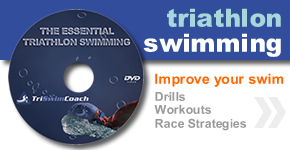 THE ESSENTIAL TRIATHLON SWIMMING DVD
THE ESSENTIAL TRIATHLON SWIMMING DVD
Discover the secrets to improving your swim technique, avoiding painful injuries, and shaving minutes off your best triathlon times to date! Are You Ready To Make A Change In Your Athletic Life?
ETIQUETTE
Ron Saetermoe
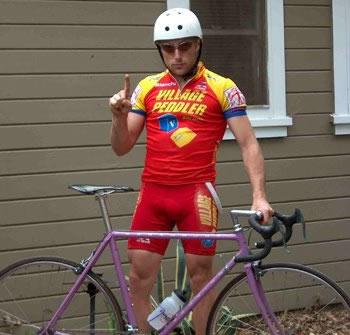 I don’t hear it talked about much but etiquette plays a big part in our sport. It hit me Saturday as I was riding on Santiago Canyon.
I don’t hear it talked about much but etiquette plays a big part in our sport. It hit me Saturday as I was riding on Santiago Canyon.
I saw a guy with a flat on the other side of the road and I called out “Need anything?” For those of you that don’t know, essentially what I was asking is whether he had everything he needed to fix whatever problem he was having.
No sooner did I call out that he yelled back “Ron?” It was my buddy Al Gaspari – the same guy I did the Honu 70.3 with a few weeks back.
I crossed over to discover he had a flat so I watched him change it and we chatted. I’ve made similar stops for people over the years. It’s really a good feeling being able to help someone out.
The first time I remember needing such help was at the Malibu triathlon. I finished the swim and got to my bike only to find out I had a flat. Oh well, no PR today. I changed it hastily (bad idea) and started out. No sooner did I leave transition that I got another flat.
I started to fix it again and snapped the valve stem. Well, that was the end of my day. At least I didn’t have far to walk to the car. My first DNF . . . or was it?
There was a guy, a cyclist, watching the race and saw my dilemma. Flat with no more spares. He looked over the situation and not only gave me a tube but he helped me change the flat as well. A good Samaritan I thanked but will never see again.
I think most of us in this sport are the same. I think we watch out for each other and encourage each other, even if we’re in the same age group. It would be a shallow victory for me to beat one of my main competitors when they weren’t at their best.
So next time you see someone pulled over to the side of the road, yell out “Need anything?”
Cheers!
Ron
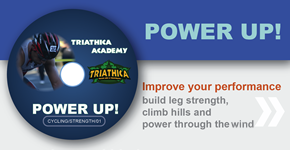 POWER UP!
POWER UP!
Triathica is introducing the first DVD in the Triathica Academy series: Power Up! Power Up! is a 60-minute spin workout designed to help build your leg strength to climb hills and power through the wind.
HOW IMPORTANT ARE RACE WHEELS?
Ron Saetermoe
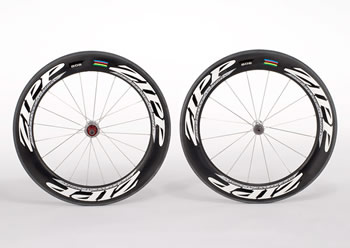
Undoubtedly you’ve seen some really “hot” wheels at your triathlon races. If money is no object you can spend upward of $3,500 for two wheels! Insane, I know, but you’ll see plenty of them at the big races.
First, what are race wheels? Race wheels include solid rear disc wheels as well as deep rim and tri-spoke wheels. There are many different companies that manufacture them and many different varieties.
You’re also aware there are tubular and clincher wheels, aren’t’ you? Tubular tires are thought to be faster overall (but new clincher technology is close behind) but very difficult to change. Essentially tubulars include the tire (the outer part that makes contact with the road) and the tube (the part that holds the air) together as one unit and is glued to the wheel. Clinchers are tires that “clinch” the wheel and have a separate tube inside.
So should you use race wheels? As usual, it depends.
Here are some factors you should consider:
• How competitive are you? If you’re really just racing for fun and are not competitive in your age group it’s not that important. The timesavings, in the right situations, will only save you a fraction of your overall time.
• How important is the race? If it’s not your “A” race (your most important race) you probably don’t need them. Because of the cost, it probably doesn’t make sense to drop all that extra money just to look good.
• What race are you doing? Some races, particularly hilly races, will change your strategy a bit. The added aerodynamics may be offset by the additional weight of a rear disc, for example.
• What length are you racing? You’ll find race wheels at all distances of races from the shortest sprint to full Ironman races. The advantage is relative. Where they may save you 10 seconds on a 12-mile ride they may save you several minutes over the course of an Ironman.
• What about the wind? The primary thing that differentiates race wheels from regular wheels is rim depth. The problem is the greater the rim depth the more difficult it is to manage the bike in a crosswind. For this reason, they do not allow full-disc wheels at the Ironman World Championships because the side-winds are almost always a factor. Lighter riders should also be careful because they will be particularly susceptible to strong winds.
• How’s your head? Many people “think” they’re faster with race wheels, therefore they are. I agree with this, by the way. When my bike is decked out with a set of Zipps, I just “feel” faster.
If you’re concerned about maximizing your aerodynamics but you’re on a budget, it’s probably best to rent race wheels for your “A” races and take the extra dough and enter a couple more “B” races.
TWEAKED
Ron Saetermoe
 Earlier this week a friend of mine and I were moving some stuff . . . some heavy stuff. We moved three large laser printers, two treadmills and some boxes. I don’t know what the printers weighed but the treadmills were 355 pounds each!
Earlier this week a friend of mine and I were moving some stuff . . . some heavy stuff. We moved three large laser printers, two treadmills and some boxes. I don’t know what the printers weighed but the treadmills were 355 pounds each!
We moved all this stuff without incident and then . . . you guessed it . . . . I tweaked my back lifting one of the boxes that probably didn’t weigh but 10 pounds!
Naturally, the thing I thought of first was whether or not I could continue to do my workouts! Funny how we think.
How you deal with injury depends on so many factors. How severe the injury is, your next race, your tolerance for pain, your dedication, your training phase, and even your doctor’s recommendations (I put that one last because most times it seems this is the least important to us).
For me, I subscribe to the “let’s wait and see” philosophy. Rather than call my doc (Dr. Sam Sunshine) and have him order x-rays, MRIs and cortisone injections, I just wait and see. Let’s just see how bad this injury is rather than overreact.
So Tuesday comes around and I’ve got a one-hour CompuTrainer session scheduled. While it’s hard to lift my right leg and get it over my bike, I manage to hoist it over and start spinning. Guess what? It’s a little painful, but tolerable. Okay, this is good.
I’m writing this Friday so it’s been four days since I hurt myself and the pain is still there to be sure. However, since that time I’ve managed to keep working out including a marathon resistance training session yesterday. Very cool!
The real test will come tomorrow though because I plan to ride the 93-mile Palomar loop. Should be nice and hot too! This sufferfest isn’t for the faint of heart but I think my back will hold out.
Now, if my condition gets worse, or if I can’t manage the pain with Aleve alone, I will go see the good doctor, but until then, “rock on!”
Cheers!
SHORT OR LONG?
Ron Saetermoe
 For those of us that work for a living, finding time to train can be one of the biggest challenges you face to reaching your triathlon goals. There simply don’t seem to be enough hours in the day to get everything done.
For those of us that work for a living, finding time to train can be one of the biggest challenges you face to reaching your triathlon goals. There simply don’t seem to be enough hours in the day to get everything done.
The debate still rages on regarding how much training is the right amount. Naturally, you’ll need to train longer if you’re doing 70.3 and Ironman stuff, but how much is enough?
The legend Mark Allen seems to subscribe to the “more is better” school of triathlon training. If you’re training for an Ironman you’d better be prepared to put in 20+ hours of training per week. That’s a part-time job on top of your full-time job!
On the other hand, you’ve got Russ Jones from the “less is best” school of triathlon training. Granted, Russ specializes in shorter triathlon distances but his basic philosophy is shorter sessions but with more intensity.
So who’s right?
Here’s my take on it: they’re both right.
Let me just say that I’m a huge believer in the benefits of cycling with a trainer and running on the treadmill. Can you still become a great triathlete without these tools? Probably, but it will take more time.
Essentially the trainer and treadmill allow you to pack a huge amount of quality training into a tiny chunk of time. Generally my CompuTrainer and treadmill sessions are 60 minutes each. In order to get the same quality of training on the road I might have to do double that, or even more.
And it doesn’t stop there. Your trainer and treadmill sessions should be intense, not easy. You need to rev up the speed, watts and incline to get a real quality session. If you do, you’ll feel quite wasted afterwards but will find that it really helps improve your fitness. When I get off my CompuTrainer at the end of a tough session I can barely stand.
The benefits of the long stuff can’t be overstated either. It’s easier for me to do my long sessions on Saturday and Sunday because I rarely work an entire day during the weekends.
These sessions are more about endurance and pacing than building strength. The other benefit they have is confidence building. If you do a 100-mile bike ride in practice, that 56-mile ride for your 70.3 won’t be as intimidating.
You also benefit by incorporating the long stuff into your workouts by validating your nutrition plan. Less important for sprint distance races but your nutrition plan becomes more important as your races get longer.
So to really maximize the benefits of you limited training time the answer is short AND long.


